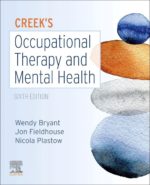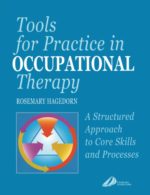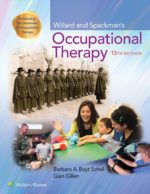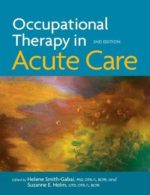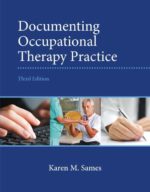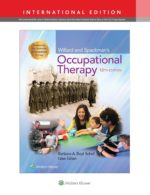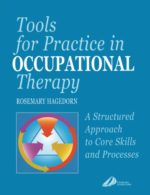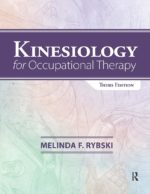-
Conditions in Occupational Therapy-Effect on Occupational Performance Edition: 6
KSh 19,500.00This updated 6th Edition is fully aligned with the most current DSM-5 and Occupational Therapy Practice Framework, 4th Edition, and adds new chapters reflecting recent advances in the management of infectious diseases, general deconditioning, musculoskeletal pain, amputations, and sickle cell anemia. Each chapter follows a consistent format, presenting an opening case followed by descriptions and definitions, etiology, incidence and prevalence, signs and symptoms, diagnosis, course and prognosis, medical/surgical management, impact on occupational performance, and two case illustrations.
Rounded out with robust instructor resources and new full-color imagery, this bestselling resource is an essential tool for today’s occupational therapy and occupational therapy assistant students.
NEW! Five new chapters detail current practices in the management of:
-Infectious Diseases
-General Deconditioning
-Musculoskeletal Pain (back, neck, upper and lower extremity)
-Amputations
-Sickle Cell Anemia
NEW! Full-color images clarify concepts and procedures in vibrant detail.
Updated content and references reflect the latest insights on the neurological basis for disorders, brain/behavior relationships for psychiatric disorders, and a consistent list of client factors affected by disorder.
Integrated pathophysiology and occupational therapy coverage ensure a comprehensive understanding without the need for multiple texts.
An intuitive organization groups disorders logically for fast, efficient reference.
Chapter-ending Case Studieshelp you apply content to real-life clinical situations, including both pediatric and adult cases where relevant.
Introductory Cases immerse you in chapter content for greater retention and understanding.
In-text learning aids, including key terms, study questions, recommended learning resources, and special boxes, tables, and displays help reinforce key concepts. -
Occupational Therapy for Older People 1st ed. 2020 Edition
KSh 15,700.00This book focuses on evidence-based occupational therapy in the care of older adults in different clinical settings, from home to acute hospital, from intensive care unit to rehabilitation centers and nursing homes. Occupational therapy has progressively developed as a new discipline aiming to improve the daily life of individuals of different ages, from children to older adults.
The book first reviews the interaction between occupational therapy and geriatrics and then discusses in depth how occupational therapy interventions are applied in the community, in the acute hospital and in the nursing home. It highlights the key role of occupational therapy in the management of frail patients, including critically ill older patients and persons with dementia, and describes in detail how to maintain occupational therapy interventions across different settings to avoid the fragmentation of care.The ageing population requires new innovative approaches to improve the quality of life, and as such this book provides clinicians with handy, key information on how to implement occupational therapy in the daily clinical care of older adults based on the current scientific evidence.
-
Creek’s Occupational Therapy and Mental Health, 6th Edition
KSh 12,380.00Promoting and maintaining mental health continues to be a key challenge in the world today. Creek’s Occupational Therapy and Mental Health is essential reading for students and practitioners across a wide range of health professions, capturing contemporary practice in mental health settings. Now fully updated in its sixth edition, it retains the clarity and scholarship associated with the renowned occupational therapist Jennifer Creek while delivering new knowledge in a fresh perspective.
Here readers can find everything they need on mental health for learning, practice, and continuing professional development. Complex topics are presented in an accessible and concise style without being oversimplified, aided by summaries, case studies, and questions that prompt critical reflection. The text has been carefully authored and edited by expert international educators and practitioners of occupational therapy, as well as a diverse range of other backgrounds. Service users have also co-authored chapters and commentaries. Evidence-based links between theory and practice are reinforced throughout.
This popular title will be an indispensable staple that OTs will keep and refer to time and again.
-
Tools for Practice in Occupational Therapy, 1st Edition
KSh 11,460.00This key text has been written to bridge the gap between the books on the theory of occupational therapy and those which look at the occupational therapy management of specific conditions, i.e., it links the theory to practice. It looks at the 4 core processes which form the basis of the unique practice of OT: assessment and evaluation of individual potential and performance, occupational analysis and adaptation, environmental analysis adaptation and therapeutic use of self. It introduces the student to the scope and purpose of each of these processes and gives practical information about their application in relation to working with adults.
A practical guide to the core skills and processes of occupational therapy
Outlines the theory but firmly relates it to practice
Introduces a process-based client-centred model: Competent Occupational Performance in the Environment (CORE)
Reflects the latest thinking in OT including occupational and environmental analysis
Highly readable and free of jargon -
Quick Reference Dictionary for Occupational Therapy-7th edition
KSh 10,920.00A leading resource for occupational therapy practitioners and students for 20 years, now updated with the latest information in the profession, Quick Reference Dictionary for Occupational Therapy, Seventh Edition is a resource for daily practice and academic training.
Quick Reference Dictionary for Occupational Therapy, Seventh Edition by Dr. Karen Jacobs and Laela Simon remains the only comprehensive dictionary available specifically for occupational therapy. Containing more than 4,000 words and definitions, more than 60 appendices, and illustrations, graphs, and tables throughout, this definitive text has been updated with the latest information in current occupational therapy practice.
New appendices in the Seventh Edition include:
Commonly Used Assessments
Emerging Practice Areas
Expand Your Knowledge
Grading Versus Adapting a Task
Hand Pathologies
State Regulatory Entities
Theories and Frames of Reference
Useful Apps
A handy, conveniently sized reference in an easy-to-use format, Quick Reference Dictionary for Occupational Therapy, Seventh Edition gives occupational therapists, occupational therapy assistants, faculty, and students the most pertinent information they need day to day, right at their fingertips. -
Willard and Spackman’s Occupational Therapy 13th edition
Celebrating 100 years of the Occupational Therapy profession, this Centennial Edition of Willard & Spackman’s Occupational Therapy continues to live up to its well-earned reputation as the foundational book that welcomes students into their newly chosen profession. Now fully updated to reflect current practice, the 13th Edition remains the must-have resource that students that will use throughout their entire OT program, from class to fieldwork and throughout their careers. One of the top texts informing the NBCOT certification exam, it is a must have for new practitioners.
Packed with first-person narratives that offer a unique perspective on the lives of those living with disease, this edition offers much that is new as it continues to help students and clinicians develop the knowledge and skills they need to apply a client-centered, evidence-based and culturally relevant approach across the full spectrum of practice settings.
-NEW! Each Unit is now reflective of the nomenclature for the new domains and processes covered in AOTA’s Occupational Therapy Practice Framework, 3rd Edition.
-NEW! “Centennial Notes” sections showcase perspectives from the history of OT, providing inspiring context to students entering the profession.
-NEW! A stronger global focus, which reflects more the professional as a global entity, prepares students to work effectively in today’s global environment
-NEW! Coverage of the latest considerations in the field prepares students to work with the full range of clients, including veterans suffering from PTSD, the homeless, and individuals who identify as LGBTQI.
-COMPREHENSIVE: The 13th Edition is the only text in the field to cover the full breadth and scope of occupational therapy, summarizing important and complex material in a completely accessible way.
-INTEGRATED: Integrated coverage of evaluation and intervention processes gives students a holistic overview of the field.
-PRACTICE-ORIENTED: Case Studie s serve as models for problem-solving in dealing with clients, practice issues, and managing OT services and staff.
-INVITING: A striking full-color design filled with photos and illustrations welcomes today’s students into this classic text.
-STUDENT-FRIENDLY : In-text learning aids, including Chapter Outlines. Learning Objectives, and Practice Dilemmas, help students master the material and prepare them for the current realities of OT practice.
eBook available for purchase. Fast, smart, and convenient, today’s eBooks can transform learning. These interactive, fully searchable tools offer 24/7 access on multiple devices, the ability to highlight and share notes, and more -
Occupational Therapy in Acute Care-2nd edition
Occupational therapy is an allied health profession with an underlying belief that engaging in occupations promotes both health and wellness. This comprehensive text lays the foundation for occupation-based practice and addresses the contextual issues of working within the acute care setting. The chapters help to demystify medical conditions and issues routinely encountered by occupational therapists working in this practice area. Detailed research covers the importance of occupational therapists’ knowledge of how diseases affect the human body, including the cardiovascular, nervous, and endocrine systems. Chapters review the evaluation process, including chart review, measures, and interpretations and recommendations for intervention to ensure the ultimate level of independence for each patient. Occupational Therapy in Acute Care is designed specifically for therapists working in a hospital setting to acquire better knowledge of the various body systems, common conditions, diseases, and procedures. Students and educators will find this new publication to be the most useful text available on the topic.
-
Documenting Occupational Therapy Practice-3rd Edition Karen Sames
A comprehensive guide to creating effective documentation in occupational therapy.
Documenting Occupational Therapy Practice, 3/e is the most comprehensive text on occupational therapy documentation currently on the market, covering general documentation principles, clinical documentation, electronic documentation, school system documentation, and documentation of administrative tasks. More than just a how-to manual, the text explores important ethical, legal, and language issues related to documentation in addition to presenting step-by-step strategies for creating successful SOAP notes, communications, and documentation. The Third Edition has been fully updated to reflect current AOTA official documents and new electronic documentation tools, and has been reorganized to improve readability. Effective review tools help readers truly master documentation techniques and strategies, while the text’s accompanying website provides additional learning resources that can be accessed on the go.
Teaching and Learning Experience
This text offers a comprehensive guide to creating effective documentation for occupational therapy. It provides:
Comprehensive coverage of all areas of practice: Chapters examine the underlying concepts of good documentation in clinical, school, and administrative settings.
Practical techniques and strategies that prepare students for the workplace: Chapters present clear, effective strategies for drafting documentation and communication that can be directly applied in professional settings.
Exploration of ethical and legal issues: Discussions help students understand how documentation affects others and provide problem-solving strategies for addressing legal and ethical issues.
Coverage of electronic documentation: Screenshots and discussion of electronic health record (EHR) systems familiarize students with current documentation technologies.
Effective learning tools: Review exercises and numerous reference tools help students truly master text material. -
Willard and Spackman’s Occupational Therapy-by Barbara Schell
This authoritative text delivers a rich and dynamic introduction to the field of occupational therapy, combining theoretical foundations with practical application. Written by leading experts Barbara Schell and Glen Gillen, the book provides students and practitioners with a deep understanding of the principles, models, and processes that define modern OT practice.
With a strong emphasis on occupation-based, client-centered, and evidence-informed approaches, the book equips readers to meet the diverse needs of individuals across the lifespan. It explores a wide range of practice areas—from pediatrics to geriatrics, mental health to physical rehabilitation—while addressing contemporary issues such as health disparities, interprofessional collaboration, and evolving technologies.
Each chapter is structured to foster critical thinking and clinical reasoning, using real-life case examples, assessment strategies, and treatment planning tools. Whether you’re a student preparing for fieldwork or a clinician seeking a reference guide, this book is designed to support your growth and confidence in occupational therapy practice.
-
Tools for Practice in Occupational Therapy 1st Edition by Hagedorn (Author)
A practical guide for students and professionals, Tools for Practice in Occupational Therapy by Hagedorn offers evidence-based techniques, case studies, and hands-on tools to enhance clinical reasoning and effective intervention planning
This key text has been written to bridge the gap between the books on the theory of occupational therapy and those which look at the occupational therapy management of specific conditions, i.e., it links the theory to practice. It looks at the 4 core processes which form the basis of the unique practice of OT: assessment and evaluation of individual potential and performance, occupational analysis and adaptation, environmental analysis adaptation and therapeutic use of self. It introduces the student to the scope and purpose of each of these processes and gives practical information about theirapplication in relation to working with adults.
A practical guide to the core skills and processes of occupational therapy
Outlines the theory but firmly relates it to practice
Introduces a process-based client-centred model: Competent Occupational Performance in the Environment (CORE)
Reflects the latest thinking in OT including occupational and environmental analysis
Highly readable and free of jargon -
Kinesiology for Occupational Therapy 3rd Edition by Melinda F. Rybski (Author)
Kinesiology for Occupational Therapy, Third Edition covers the theoretical background for understanding the kinematics and kinetics of normal human physiological movement. Each specific joint is assessed in terms of musculoskeletal function, movements possible, and an overview of pathology that may develop. Dr. Melinda Rybski covers four occupational therapy theories related to functional motion that are important for occupational therapists to know. This Third Edition has been updated to reflect the current field and includes new information that has emerged in recent years.
New in the Third Edition:
Content closely follows AOTA’s Occupational Therapy Practice Framework and Occupational Therapy Vision 2025
Updated and more extensive provision of evidence that summarizes key findings in current literature
New theories are presented in the Intervention sections
Extensive, joint specific and theory-based assessments are provided
Interventions described are occupation-based, process-based
Kinesiology concepts presented in a practical, useable way
Expanded chapters for Spine and Thorax and Hip and Pelvis.
Included with the text are online supplemental materials for faculty use in the classroom.Kinesiology for Occupational Therapy, Third Edition clearly outlines the need for an understanding of kinesiology in occupational therapy, providing occupational therapists with the evidence necessary to support their intervention strategies.



